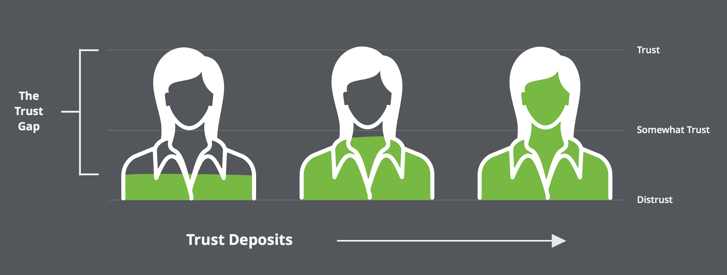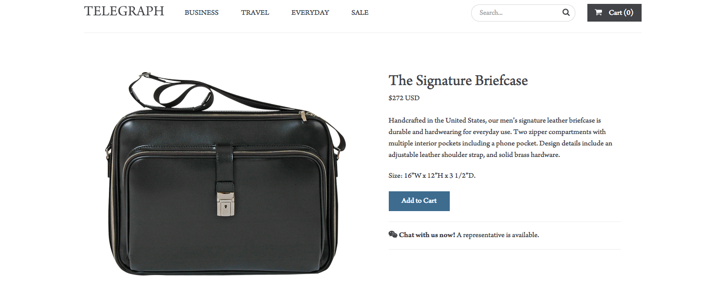The dream of any ecommerce site owner is to have visitors buy their product, love it, tell their friends about it, and come back again. For that to happen, an online merchant has to create a trustworthy online store. So how do you help your clients build a trusted site?
It begins with the user experience. A visitor needs to believe that the business is trustworthy, the site is safe, and the product is worth purchasing. But with hundreds of thousands of unknown ecommerce sites joining the Internet every day, customers don't know how to sort through the ones they can trust and the ones they can't.
According to a survey conducted by Harris Interactive, 94% of online consumers worry about their security on the Internet. This issue has grown due to the very public data breaches that have occurred over the past year, resulting in a climate of fear for most Internet users.
Consequently, there's a trust gap among online shoppers, with new or less well-known online retailers needing to bridge that gap and prove they are trustworthy to customers. To eliminate the trust gap, new businesses can make small changes and improvements (which we like to call trust deposits) to their online store that will help increase trust among website visitors and increase their sales. In other words: Visitor Trust = Transactions, Repeat Purchases, and Referrals.

Here are five tips and tools to help build a trusted site for your clients.
You might also like: Marketing Your Shopify App: The App Listing Page
Be up front about pricing and return policies
Clear pricing with a visible return policy makes visitors feel like they can purchase from a company without added risk. Out-of-nowhere fees and shipping costs that aren't revealed until the last moment in the sales funnel are hallmarks of companies that consumers really don't like doing business with.

When a return policy is hidden or hard to find, a visitor is likely to become skeptical before completing their purchase. This is one of the reasons that an average of 68% of people abandon their shopping carts. Website owners can give visitors the reassurance they need to make a purchase by putting all pricing and a well-written return policy front and centre.
The move:
Include as much info as you can, as early as you can in the buying process. If there's going to be a shipping cost, tell them what the minimum is. If there's a strict return policy, don't let consumers get close to checking out before telling them.
Bonus: Shopify has a number of apps that can help you create a seamless shipping and return process for you and your visitors.
Make sure customers know the site is safe
This is both a no-brainer and a tricky proposition. Of course your client wants customers to know that their site is free from malware, phishing, and security holes. But how do you show it?
Because most visitors aren't security experts, they won't know how to determine if the site is safe. What they will do is look for a sign, like a seal from a well-known security company. When asked to choose between a site with a trustmark over a site without one, 75% of consumers reported they would choose a site that has a security mark, logo, or seal.
So which of the below looks more trustworthy?


On average, the second image with the McAfee SECURE trustmark generates a 10% increase in sales for smaller ecommerce sites.
Security seals act like referrals from large security companies, telling everyone who sees them that this site has been tested and scanned, and is free from all those bad things that go bump on the Internet.
The move:
Head over to the Shopify app store and get yourself a security seal from a company that you yourself recognize and trust.
Show the people behind the brand
Visitors want to see that behind the product, there are real people working in a real office — not just staged product pics taken in some photographer's handsomely-lit studio.
In fact, 62% of consumers want to see indications that there is a legitimate business behind a website. Putting real people, real names, and real phone numbers behind the business gives visitors confidence that they can actually get a hold of someone if needed. It builds trust and removes risk for the visitor, knowing that there is a legitimate business behind the website.

The move(s):
Add photos and fun facts about your client's team. People are visual creatures who connect to others through images, so don't skimp!
Also, be sure to include plenty of contact options because different consumers prefer to reach out in different ways. So get a phone app, a live chat app, and a contact form for your site.
You might also like: How Improving Your App Store Banner Can Increase Traffic by 400%**
Be a social (media) butterfly
So what do you do after you've created a happy customer? Get that satisfied customer to promote how much they love the site and product on their social media accounts to drive new customers.
In the year 2015, every company has (or should have) a social media presence. People turn to a company's Facebook or Twitter page to learn more about the brand or to comment on their customer experience. Loyal customers are more apt to leave reviews or talk about a company or product on social media — establishing social proof for your business. Seeing good reviews or a friend's or family member's social approval of a company is a powerful endorsement and is a trust deposit for your brand.
Plus, much like showing pictures of real people, being active on social media shows consumers that there are human beings behind the product. It also makes it easy for visitors to learn what your clients are all about. Add links to social sites and their blog within the header or footer of your website so visitors can quickly learn more.

The move:
On the order confirmation page, prompt customers to share the product they just purchased on Facebook or Twitter. Get as many social apps as your client has the bandwidth to run and ask them to start putting themselves out there!
Get ratings and reviews
Like security seals, ratings and reviews are third-party endorsements that customers can look to before making the decision to buy. A company or product with no reviews can be very intimidating for consumers (and is a trust withdrawal), because all they have to go on is your word.
Conversely, when people see that a company or product has lots of stellar reviews, they'll gain confidence, knowing that a business is honest and trustworthy.
The move:
You'll definitely want to get as many positive ratings and reviews as possible, so go and rustle them up! Post purchase, merchants should follow up with customers (who have hopefully had a great customer experience) and offer them a discount or free service for completing a review or sharing the site with others.
To do that, of course, you'll need a review app enabled on the site. Head over to the app store, get a review app you think your client will like, and get those testimonials flowing in.
Wrapping up
Keep in mind that these are just a few of the many things you can do to help your clients build a trustworthy site. Closing the trust gap and becoming a trusted site leads to more visitors, loyal customers and increased sales.
Let us know in the comments if you have other great suggestions!
Read more
- How to Boost Your Business’s Revenue with Ongoing Service Retainers
- 3 Ways to Use a Phone Number to Boost Your Client’s Business
- What I Learned From Being My Own Client
- Grow Your Business With This Free Book
- How to Get the Most out of Shopify Pursuit: A Conference for Growth, Connection, and Community
- 7 Ways to Create an Amazing Customer Experience for Your Clients’ Ecommerce Stores
- Strategies for Successfully Defining and Winning Client Projects
- 5 Retail Industry Trends to Get your Clients Excited about Shopify POS and Offline Selling

